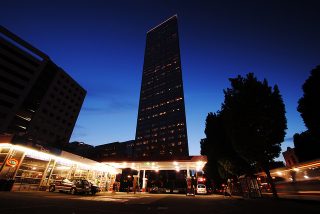
(Photo: C.M. Keiner)
Editor’s note: We’re highlighting this (lightly edited) BikePortlander post as a comment of the week. It’s a doozy, but it’s provocative. The author, A.J. Zelada, is a past contributor who has volunteered as a transportation advisor for Oregon and others.
Now that Black Friday came and went, I want you to rethink the gas-tax approach to boosting active transportation revenue.
I think the gas tax is a snake eating its own tail. It undermines the serious effort we need.
Yes we want every cent. Yes, We want to reduce the number of ‘cars’ that represent 50% of all car trips taken. We know that 50% of all car trips are 3-4 miles or less. Our message is generally that if you walk or bicycle 3 miles, you are going to be healthier. That was our goal in the past. It was also known that we need to attract even more people to our bicycling and pedestrian world and we need the perception of safety for that invitation with real protected lanes. Enough of 4 types of bicyclists, on to making the demographics of people being an active type that represents the vibrancy of our society not the sedentary automobile driver going a mile to pick up supper.
1. It doesn’t make sense to me to be taking from gas revenues for some thing that we want to reduce. It’s like investing in movie theaters so we can develop a grant to stimulate independent film makers. Who would do that? In Oregon, we are a declining driving population.
2. We need to build infrastructure. We can’t be making more bicycle lanes that sandwich bicyclists and turning automobiles at intersections. What dad or mom wants to be in between cars turning across their lanes with their kid in tow or on their cargo bike? It is not inviting and ratchets down the perception of safety for the novice bicycling parent & child.
3. Our economy is changing dramatically.
Let’s look at Black Friday.
Last year, it was predicted that 45 percent of all Christmas sales were going to be on the internet. Last year, internet sales were 49 percent of all Christmas sales. Money spent at internet sites increased by 8.3 percent last year.
This year, 15 percent of all the U.S. malls closed or are to close by Dec 31st, 2015.
Fewer people are driving to the mall. No one drives to the internet to buy Stuff. But guess who delivers those consumer items? Yes: Freight. So, our decreased driving society to buy Stuff will translate into increased goods being delivered by increased freight on the road.
If you were freight and saw this pattern, one could think: I need more money for roads, especially their maintenance. And: getting cars off the road means more efficiency for delivering shipped goods.
If you were an active transportation planner, you could make the realization that we need more than trickles of dollars every two years to create a real infrastructure.
If you were an active transportation advocate, it is easy thinking I want more of my share of the declining gas tax revenue. But the irony is that you will be facing a greater adversary than ever.
Gas tax carving pits user against user, making them fiercer adversaries. Even with support of the Oregon Transportation Forum’s suggestion of more gas tax revenue going to active transportation, one needs to look more deeply. Jump ahead two months after they initiated the increased percentage of gas taxes for active transportation and read all the letters against such a measure in the submitted committee notes. One realizes the chess moves against creating active transportation infrastructure with that increased tax revenue proposal.
The current debate about Matt Garrett is interesting in this Shakespearean drama. He was directed by Gov. Kitzhaber to appoint a multi-modal person on each Area Commission for Transportation. These people on each ACT should be saying, ‘we need to spend money on moving people in a safe manner, be it sidewalk, bicycle lane, transit, rail, etc.’ Matt executed this well and promptly.
But again this ‘oomph’ died as we lost a key player, the governor. We continue to be stuck arguing over declining gas tax revenue, which are nickels and dimes in couch cushions. We have no leader that says, “Infrastructure needs passion, political will, high level personnel with history & experience of active transportation in transportation development, and long term funds.”
Having a large multi-year plan similar to the Highway Defense Act of the 1950s or even ODOT’s OTIA bond measures of the past decade could provide a decade of money that creates an active transportation infrastructure rather than throwing a dry spaghetti-stick bicycle lane here and there each biennium.
Creating a bond measure that bundles all the sidewalk needs (400 to 500 miles in Oregon) over ten years will be much more efficient use of regions’ staff time than asking them to apply five times for 20 percent of each of the projects to complete 1/5 of their whole active transportation plan. Asking for a 1 percent increase to gas tax gives you $6 million to perhaps $10 million per biennium. And what does buy? The same old spaghetti bike lanes painted white with an inch by inch infrastructural development.
Does that make the new potential user more comfortable, safer or even invited? One does not often think about Black Fridays, gas taxes, and the sad state of our political will but it is an old soup. And a new year is coming.
For more details: http://72km.org/oatia.html

